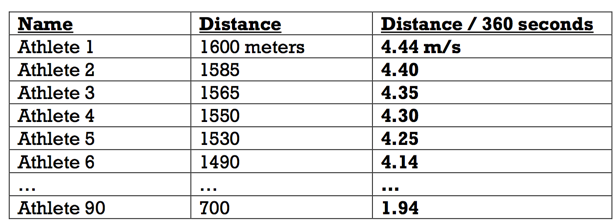Performance Coaches Should Condition Athletes With More Precision
As strength and conditioning coaches, many of us feel comfortable with programming and implementing precisely periodized strength training for our athletes. My goal in this article is to share and explain a simple aerobic training protocol to provide the same precision that can also be implemented effectively by any coach at any level.
Coaches can teach athletes basic movement patterns in the weight room, load them and then assess athlete performance gains in that energy system. Obviously, this is more effectively done by customizing and individualizing programs. Coaches may even employ standards of strength by position. For example, football typically uses the classic breakdown of Big, Mid, Skill (Eg: Tanks, Bombers, Jets at my program Norfolk State). But even implementing sets, reps, or percentages based solely on position would not exceed the results yielded by individualized programming. Too often conditioning-based programming relies on positional standards.
In our program for instance, one particular 270-pound defensive lineman can run all day long while another 340-pound defensive lineman does not run nearly as well. Does asking these two athletes to run 110-yard sprints or gassers at the same time requirement make sense?
With that in mind, we asked ourselves:
"Are certain athletes getting in better aerobic shape or are we simply making them tired?"
In our case, the rest times administered were too short for athletes to fully recover, so the number of reps, distance or speed dropped as the session went on. Along with that, the volume was too high to improve speed and power. We concluded the conditioning performed at that time was putting the athletes into what we called the ‘Mediocre Middle.’
To address this, we developed and implemented a system that requires the athletes to meet standards that are based on individual performance. The same way strength coaches program squats at 70% for 3x5, this system prescribed a similar method for conditioning.
The first step is to test an athlete’s aerobic capacity. A simple six-minute run test on a track suffices to negate any speed advantage while effectively tapping into the aerobic system. Our staff actually hypes this test up like any other test performed in the weight room. Results are then posted and shared; athletes that do not perform well are made known and will be trained further until their scores improve. No one likes to see their name at the bottom of any list. Those that do perform well are rewarded consistently by performing 1-2 less reps during a session, or they are given an extra recovery shake or snack.
Here is an example of what the data will look like after testing:

Once we have the results, we divide the athletes into subgroups in order to make training a large group logistically easier by averaging the individual results into a subgroup average.
If we use athletes #1-6 from above as an example, those results would be averaged into a Group 1 average of 4.3 m/s. This process continues for the remaining athletes; 4-5 groups is a manageable number of subgroups.
Once subgroups are formed, specified conditioning training can then be programmed. The intensity, or percentage of an athlete's best pace, varies on the current phase of training and day of week just like any other training modality or exercise. Groups will condition 1 or 2 days per week in the winter, 1 day per week in the spring, 2-4 days per week in the summer and then on Sundays during in-season.
Here is an example of a 1x week training session that would be run during spring ball:

Using Group 1’s average of 4.3, we would first reduce the pace to 75% (3.23 m/s) then multiply that by the time for that session (300 seconds on week 1). This gives us ~970 meters, the distance that the group needs to cover in the allotted time - 5 minutes - which is marked on the track with numbered cones to indicate start and stop positions. After the rest period, the group reverses direction on the track, returning to the original start position.
Here is a breakdown of re-testing from our first summer:
8 weeks. 2-3x week running
Offense: 17.3% Increase in distance. Median: 1125---1325
Defense 9.8% Increase in distance. Median: 1325---1500
Offensive Line: 22% Average increase.
10% = ~100 meters.
Conclusion
- This style of conditioning will initially raise eyebrows, especially from the sport coaches who may be confused when athletes aren’t falling out on the floor or walking around with their tongue hanging out from fatigue. It doesn’t “look” hard all the time. But the athletes tend to quickly appreciate it once they understand the thought process of it being based on their own performance - not guesswork.
- Excel is imperative to staying organized with results and programming. I’m happy to share our Excel templates with anyone.
- We believe this system of “Running, Ranking, Reassessing” is great for showing a progression and a systematic approach to conditioning athletes at a time where there is a dark cloud surrounding our profession when it comes conditioning athletes.
- This system makes up approximately 90% of the total yearly volume of conditioning our program performs.
- I only have anecdotal evidence to support this claim, but our heat related issues (heat cramps, exhaustion, etc.) are nonexistent even in the humid, dog days of summer in east Virginia.
Even if you do not completely modify your conditioning program to this method, I hoped to have revealed some aspects that should be considered when programming conditioning. Please do not hesitate to contact me if I can help at all and thank you for taking the time to read this article.
Subscribe to our blog
Subscribe to receive the latest blog posts to your inbox every week.
Related posts

3 Ways College Strength Coaches Can Play a Role in Recruiting


